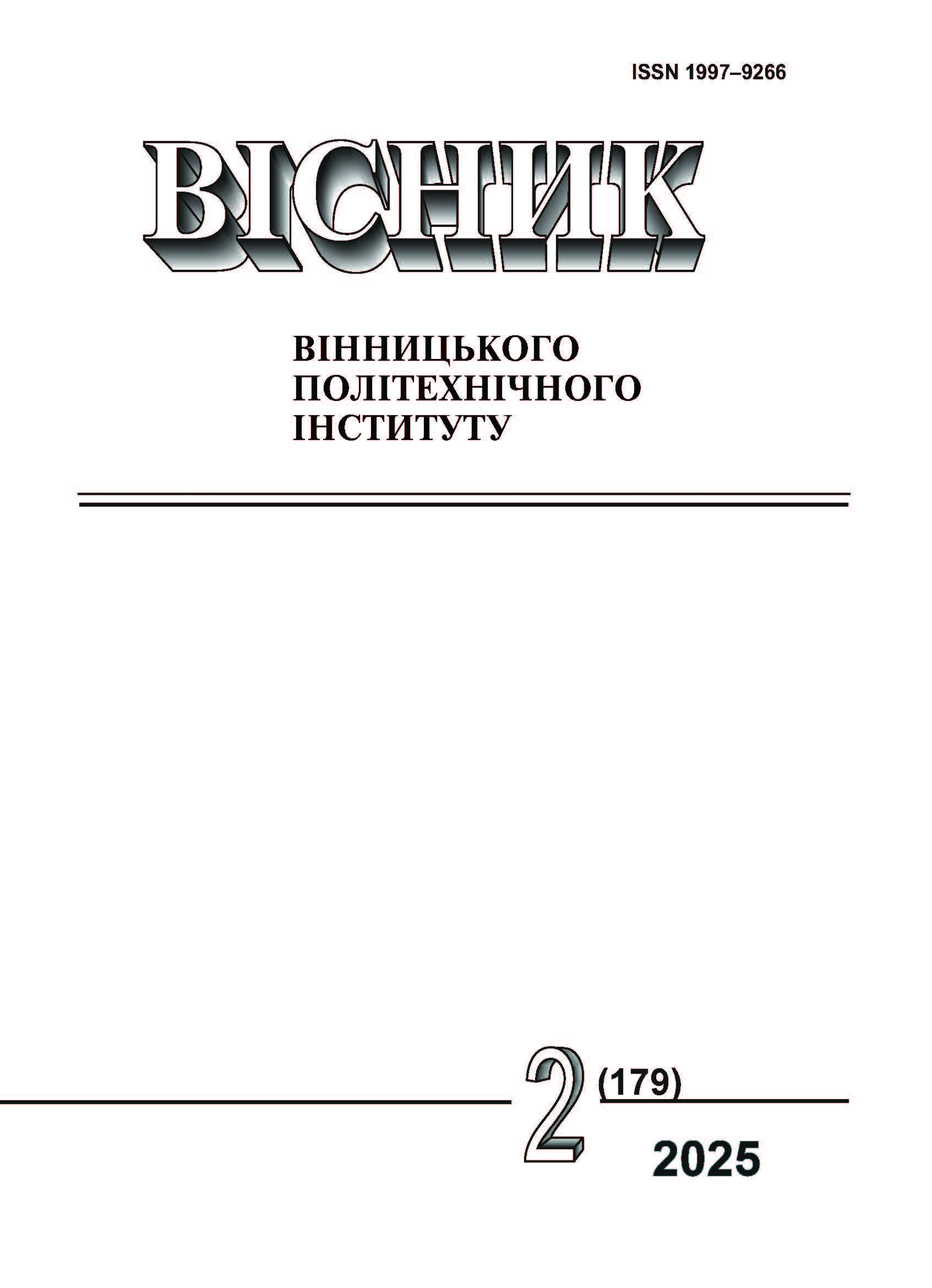НОВА СИСТЕМА ВИКОРИСТАННЯ БІОПЛАТО ДЛЯ ОЧИСТКИ РІЧОК ГІРСЬКОЇ ЗОНИ ФОРМУВАННЯ СТОКУ
DOI:
https://doi.org/10.31649/1997-9266-2025-179-2-32-38Ключові слова:
міські водні об’єкти, очищення забруднених річок, рекреаційні вимоги до водойм, гірська зона формування стоку річок, паводки, селеві потоки, технологія біоплато, гребля, біоплато поруч з руслом річки, зміна напрямку потокуАнотація
Нова система використання біоплато для очистки річок дозволяє використати технології біоплато для постійного забезпечення необхідної якості води в рекреаційному комплексі «річка гірської зони формування стоку – міська водойма для рекреації». Запропоноване рішення використовує природні процеси очищення, що підвищує ефективність використання системи біоплато. Також розглянуто проблему селевих потоків та їхніх наслідків для водних об’єктів і запропоновані механізми запобігання цьому. Разом з тим враховується економічний фактор під час вибору цієї системи поміж інших альтернативних методів для досягнення поточних цілей. Заощадження ресурсів запропонованого методу відіграє дуже велику роль в оцінюванні різних методів і може бути перевагою. Створення та експлуатація споруди біоплато вигідніша ніж інші методи. Основною відмінністю запропонованої системи є підвищення екологічної безпеки руйнуванню споруд біологічного очищення води під час імовірних стихійних лих, таких як повені та паводки. Також запропонований метод передбачає облаштування біоплато, що може мати позитивний ефект для рекреації міста. Структура роботи представлена трьома основними етапами розробки нової системи технології очищення: аналіз ефективного використання нової технології біоплато, огляд нової системи використання технології біоплато та пропозиції принципової схеми розміщення інженерних споруд нової системи очищення на конкретному прикладі.
Досліджено нову систему очищення води річки Велика Алматинка, (м. Алмати, Республіка Казахстан), що дало можливість детальніше побачити і зрозуміти усі її принципові ідеї, та розв’язати задачі, поставлені перед цією системою. На основі результатів розробки визначені головні переваги запропонованої системи і концепція цього підходу.
Посилання
S. Wuijts, M. Vries, W. Zijlema, J. Hin, and L. R. Elliott, “The health potential of urban water: Future scenarios on local risks and opportunities,” Cities. vol. 125, no. 103639, 2022. https://doi.org/10.1016/j.cities.2022.103639 .
S. Wuijts, L. Friederichs, J. Hin, and F. M. Schets, “Governance conditions to overcome the challenges of realising safe urban bathing water sites,” International Journal of Water Resources Development, vol. 38, pp. 554-578, 2020. https://doi.org/10.1080/07900627.2020.1755617 .
Аналіз та оцінка туристичного потенціалу міста Алмати. [Електронний ресурс]. Режим доступу:
https://studbooks.net/659072/turizm/analiz_i_otsenka_turistskogo_potentsiala_goroda_almaty .
A. Mussina, et al., “Mountain Resilience: A tool for mudflow risk management in the Ile Alatau mountains,” Mountain Research and Development, vol. 43, no. 1, 2023. https://doi.org/10.1659/MRD-JOURNAL-D-22-00004 .
M. Barandun, et al., “The state and future of the cryosphere in Central Asia,” Water Security, vol. 11, no. 100072, 2020. https://doi.org/10.1016/j.wasec.2020.100072 .
Л. М. Калімолдіна, Г. С. Султангазієва, С. О. Абілкасова, i С. С. Егеубаєва, «Дослідження рівня забруднення хімічними речовинами м. Алмати,» News of the National academy of sciences of the Republic of Kazakhstan Series Chemistry and technology, vol. 1, no. 458, pp. 54-69, 2024. https://doi.org/10.32014/2024.2518-1491.207 .
Наказ Міністра сільського господарства Республіки Казахстан «Про затвердження Правил встановлення водоохоронних зон і смуг.» від 18.05.2015, № 19-1/446. [Електронний ресурс]. Режим доступу: https://www.adilet.zan.kz/kaz/docs/V1500011838 .
Постанова Уряду Республіки Казахстан «Про затвердження Міжрегіональної схеми територіального розвитку Алматинської агломерації» від 24.05.2016, № 302. [Електронний ресурс]. Режим доступу: https://adilet.zan.kz/kaz/docs/P1600000302/history
A. Barco, S. Bona, and M. Borin, “Plant species for floating treatment wetlands: A decade of experiments in North Italy,” Science of The Total Environment, vol. 751, no. 141666, 2021. https://doi.org/10.1016/j.scitotenv.2020.141666 .
Ran Bi, et al., “Giving waterbodies the treatment they need: A critical review of the application of constructed floating wetlands,” Journal of Environmental Management, vol. 238, pp. 484-498, 2019. https://doi.org/10.1016/j.jenvman.2019.02.064 .
M. I. Choudhury, et al., “Disentangling the roles of plant functional diversity and plaint traits in regulating plant nitrogen accumulation and denitrification in freshwaters,” Functional Ecology, vol. 36, no. 4, pp. 921-932, January, 2022. https://doi.org/10.1111/1365-2435.14001 .
J. Brisson, and F. Chazarenc, “Maximizing pollutant removal in constructed wetlands: Should we pay more attention to macrophyte species selection?” Science of The Total Environment, vol. 407, no. 13, pp. 3923-3930, June, 2009. https://doi.org/10.1016/j.scitotenv.2008.05.047 .
Ф. К. Стольберг, Екологія міста. підруч. Киев: Либра, 2000, 464 с. ISBN 966-7035-29-8.
R. B. E. Shutes, D. M. Revitt, A. S. Mungur, and L. N. L. Scholes, “The design of wetland systems for the treatment of urban run off,” Water Science Technology, vol. 35, no. 5, pp. 19-25, 1997. https://doi.org/10.2166/wst.1997.0155 .
R. L. Knight, “Wildlife habitat and public use benefits of treatment wetlands,” Water Science and Technology, vol. 35, no. 5, pp. 35-43, 1997. https://doi.org/10.2166/wst.1997.0159 .
P. Denny, “Implementation of constructed wetlands in developing countries,” Water Science and Technology, vol. 35, no. 5, pp. 27-34. 1997. https://doi.org/10.2166/wst.1997.0157 .
К. Т. Раімбеков, і С. Т. Моомбеков, «Аналіз основних методів біологічного очищення як основа інтенсифікації роботи споруд,» Міжнародний журнал прикладних і фундаментальних досліджень, № 2, с. 45-49, 2020.
Л. Д. Пляцук, і Є. Ю. Черниш, Екологічна біотехнологія: принципи створення біотехнологічних виробництв. Суми, Україна: Сумський державний університет, 2018.
Ф. В. Стольберг, В. М. Ладиженський, Ю. І. Вергелес, О. В. Іщенко, і А. А. Худяков, «Використання очисних споруд біоплато для очищення міських стічних вод,» Науково-технічний збірник, Харківська державна академія міського господарства, № 36, с. 182-185, 2002.
М. В. Катков, «Система для біологічного очищення річок,» Патент України C02F3/32, E02B3/02. № 157284, МПК 25.09.2024.
##submission.downloads##
-
pdf
Завантажень: 54
Опубліковано
Як цитувати
Номер
Розділ
Ліцензія

Ця робота ліцензується відповідно до Creative Commons Attribution 4.0 International License.
Автори, які публікуються у цьому журналі, згодні з такими умовами:
- Автори зберігають авторське право і надають журналу право першої публікації.
- Автори можуть укладати окремі, додаткові договірні угоди з неексклюзивного поширення опублікованої журналом версії статті (наприклад, розмістити її в інститутському репозиторії або опублікувати її в книзі), з визнанням її первісної публікації в цьому журналі.
- Авторам дозволяється і рекомендується розміщувати їхню роботу в Інтернеті (наприклад, в інституційних сховищах або на їхньому сайті) до і під час процесу подачі, оскільки це сприяє продуктивним обмінам, а також швидшому і ширшому цитуванню опублікованих робіт (див. вплив відкритого доступу).





